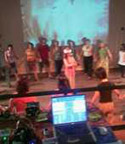April 27, 2006
Corposcópio

Circle dancing meets mobile technologies
Corposcopio is an experimental collaborative performance that associates circle dance and mobile technologies. The purpose of the interactive performance is to stimulate, simultaneously, the perception of the media in contemporary reality and the collective body emergence. Corposcopio departs from the experience of circle dance, a very ancient group activity, present in different cultures in the world, and aggregates real time image manipulation, software art, VJ, and remix aesthetics.
The transparent, ubiquitous and pervasive presence of computer systems in contemporary spaces is a quotidian fact. Nevertheless, the emergence of digital communities demonstrated the power of human factor in the disruptive use of technologies. Human beings are social beings. Our depart point is to bring an ancient practice, the circle dance, to the scenery of real time image manipulation, ubiquitous computing and mixed reality. The performance itself deals with co-creation development and uncertainty. Each performance has peculiar characteristics hence it is an open system, open to receive the group interaction and participation.
The circle is probably the oldest known dance formation. Ancient circle dances movements are cultural manifestations present in different countries around the world, including Greece, African, Eastern European, Irish Celtic, Catalan, South American, Central American and North American. They have a great power of community integration. The experience stimulates an extended consciousness, a simultaneously perception of the individual body and the collective body. Our hypothesis is that each group will catalyze the emergence of an embodied consciousness of our mediated situation in a different way. As Bernhard Wosien, one of the pioneer researchers on circle dance, has said, dance is a path to totality. In Wosien's view, circle dance has deep ritual characteristics and evokes a tremendous collective enthusiasm. In Corposcopio experience, we observed a great vibration produced by the group movement in harmony with the music. In Brazil, there is a lot of amazing circle dance and one of the most popular is called “ciranda”, whose movements are inspired by sea waves. Ciranda is performed by hundreds of people and some participants fall into trance.
The music has a fundamental role in Corposcopio project. The songs have been chosen by Andrea Leoncine and Andrea Soares, based on their research on folk music and Brazilian music. Dudu Tsuda has created new versions of traditional and folkloric songs, introducing unexpected accords and transformations on form. Tsuda's compositions are open systems that dialogue with enthusiasm and energy with the participants of the circle.
Corposcopio Project comprehends three different systems: the technological, the musical and the interactive arena, that is the place for the circle dance. The technological system is composed by systems of input and output. Two computers receive the images sent by mobile and unmovable devices. Wi-fi cameras, allocated in the dancers' bodies and cell phones transmit the images from the movable point of view. Three fixed cameras, situated around the circle and another one hanged on the ceiling provide the images from the unmoving angle. The camera situated on the ceiling transmits a design that reassembles different and dynamic mandalic patterns. The images received are manipulated in real time using Randox, software developed by Nacho Duran. The projection of images follows a script that has different levels and narrative elements.
Biography of the author
Lucia Leão is an interdisciplinary artist that has been leading researches in art and new technologies since 1989. She obtained her Bachelor of Arts degree in 1984, her MA and Ph D degrees in Communication and Semiotics: Information Technology from PUC - SP Catholic University in 1997 and 2001. Lucia Leão was Postdoctoral Fellow in Arts, in UNICAMP, Campinas, São Paulo, Brazil, from 2001 to 2005.
Leão's research is based on the hypothesis that the ancient studies of myths, labyrinths and rituals could help us to better understand and deeper interact with our contemporary mixed spaces. Her interest in the relationship between labyrinths and cyberspace led her to publish three books on this subject: "The labyrinth of hypermedia: architecture and navigation on cyberspace" (1999), “The labyrinth aesthetics” (2002), and “Interlab labyrinths of contemporary thought”(editor, 2002). She also published another books and collections. Her present research articulates the concept of nomadic wired bodies and ancient circle dances.
Lucia Leão is currently professor at PUC-SP and SENAC University, where she coordinates Cyberculture Research Group. Her articles and projects are available at www.lucialeao.pro.br
Corposcopio team
Lucia Leão
Artistic concept/direction
Nacho Duran
Software development and live image editing (VJ)
Rodrigo Gontijo
Live image editing (VJ)
Fernando Velázquez
System development and live image editing (VJ)
Andrea Leoncini
Choreographic project of circular sacred dances
Andrea Soares
Choreographic project of Brazilian circular dances
Dudu Tsuda
Musical creation
Gisele Fink
Percussion
Leonora Fink
Production
Posted by luis at April 27, 2006 12:50 PM
